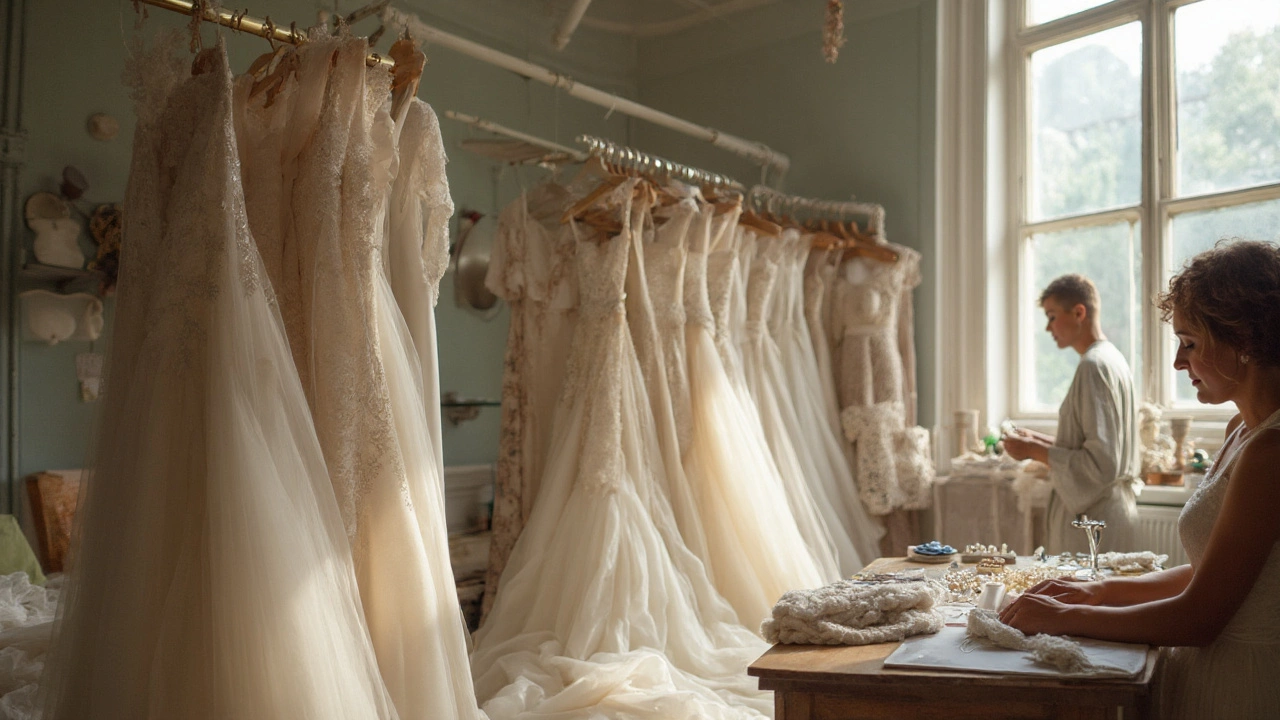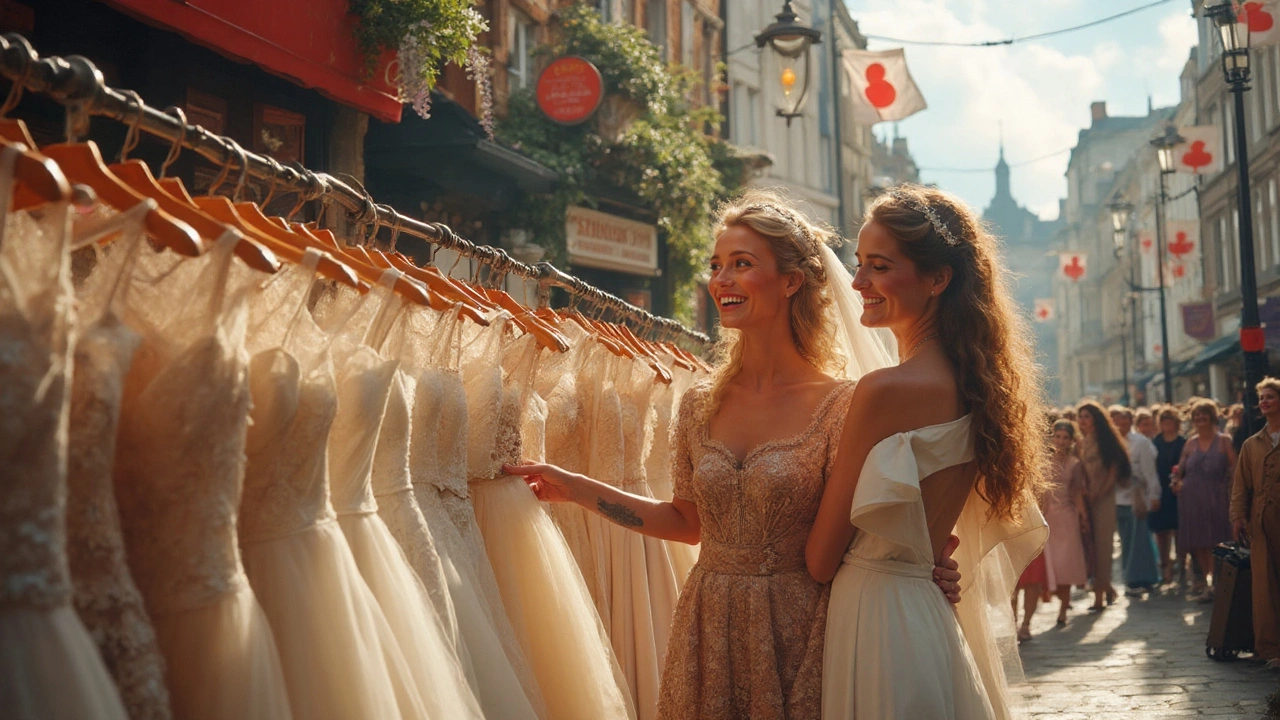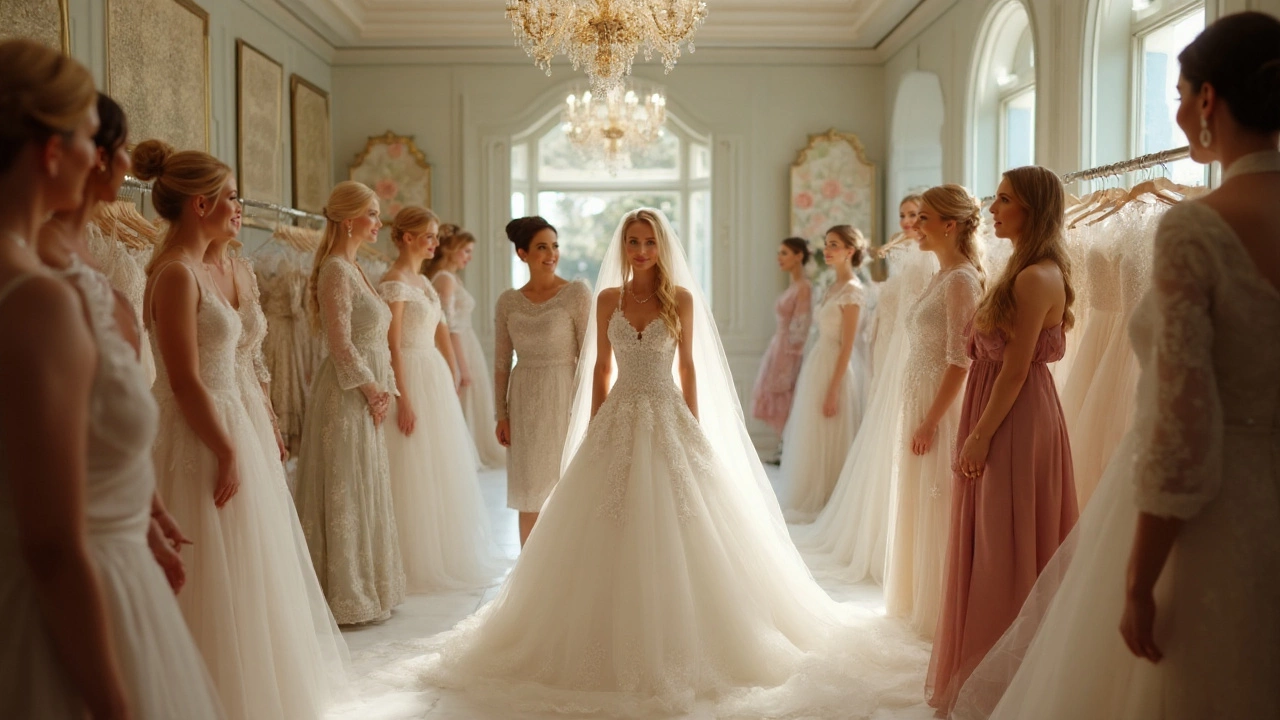Remember hearing those wild stories about brides spending more on their dress than their first car? It’s not rare. Even with Pinterest and Instagram filled with affordable options, so many still swipe the card on a gown with a price tag that could fund a European vacation. Something about that single dress—you only wear it for a few hours—makes people pull out all the stops. Is it just societal pressure or is there more brewing under the layers of tulle?
The Emotional Investment: Why Dresses Matter So Much
Ask any bride, and they’ll probably tell you the moment they put on “the one,” the feeling was electric: racing heart, maybe some tears, awkward happy dancing in front of a mirror. There’s real science behind it. According to a 2023 study by Behavioral Weddings Journal, brides who feel emotionally connected to their dresses report higher satisfaction with their entire wedding. Shopping isn’t just checking boxes—it’s an act tangled up with identity, fantasy, and expectations built from years of seeing those magical movie scenes. For a lot of women, this is their red carpet moment, and there’s pressure to dazzle. It’s much more than picking out a nice outfit. It’s the culmination of childhood dreams, family expectations, and the very personal journey to feeling like your absolute best self at a major crossroads.
Don’t forget the influence of early traditions. Centuries ago, many believed the dress should signal purity, status, or family honor. While today’s brides are rewriting those rules, there’s still that itch to pick something that signals importance. Even the color—white—wasn’t super popular until Queen Victoria rocked it in 1840, kicking off the trend for centuries.
Modern culture keeps feeding the hype. Wedding magazines, TV shows, TikTok try-ons—these visuals shape expectations even when we swear we’re immune. The pressure sneaks in. Who hasn’t scrolled through jaw-dropping wedding photos and felt a whisper of envy? There’s this hope that the perfect gown will light up the whole day, be remembered forever in photos, and make jaws drop as you glide down the aisle.
What Goes Into the Price Tag? Breaking Down the Costs
So what are brides actually paying for? It’s not just the fabric. Sure, luxurious materials can cost a small fortune. But the sticker shock often comes from the hours—sometimes 100+—that skilled hands pour into every ruffle, bead, and seam. If you’ve peeked behind the curtain at high-end ateliers, you’d see rows of artisans hunched over embroidery hoops, careful with every detail. It’s old-school craft, not an assembly line.
Here’s something wild: A 2024 industry report by Bridal Insight News estimates that for luxury brands, labor alone might make up 40-50% of the total dress cost. Handmade lace or crystal appliqués? Those don’t sew themselves, and skilled workers in cities like Paris and Milan don’t work cheap. Designers build their names by creating pieces that can hold up to Instagram closeups. They’re paying for reputation, too—name-brand designers like Vera Wang command far steeper fees than no-names.
The supply chain hits home, too. Specialty materials often ship from Italy, France, or Japan. Silk, Chantilly lace, and peculiar just-so sequins rack up extra costs, thanks to shipping and import fees. Don’t forget retail mark-ups: bridal stores typically double the wholesale cost. That’s how the boutique keeps the lights on for all those magical try-on appointments and trunk shows.
Let’s look at the numbers in a way that’s not just dry percentages:
| Cost Component | Percentage of Total |
|---|---|
| Labor (hand-sewing, embroidery, fitting) | 40% |
| Materials (fabrics, lace, beadwork) | 30% |
| Brand/Designer Premium | 15% |
| Retail Markup | 10% |
| Logistics/Import Fees | 5% |
There’s also the business side: every time someone tries a dress on, that sample needs cleaning or repairing. Stores budget for dresses that get damaged and those appointments can last hours with a consultant guiding you.

The Influence of Media and Social Trends
Here’s where things get next-level. Social media has thrown wedding dress shopping into hyperdrive. It’s not just about the aisle anymore; it’s about the viral photo, the cinematic slow-mo reveal, and the post that gets likes from people you haven’t seen since high school. Remember Hailey Bieber’s custom Off-White gown? It caused a spike in requests for designer embroidered veils—suddenly, everyone wanted “Till Death Do Us Part” stitched onto a ten-foot train.
Pinterest sets more wedding trends than glossy magazines ever did. According to Pinterest’s 2024 wedding report, searches for “unique wedding dress” climbed 120% over the past year. That’s a lot of brides looking to stand out, pushing demand for custom touches. TikTok adds extra fuel. #weddingdress has over 21 billion views. Engage in those endless try-on videos and viral “hidden detail” reveals, and you’ll see why minimalism never quite takes over.
Reality shows like “Say Yes to the Dress” have convinced people that finding The Dress is an epic quest—complete with dramatic tears, family drama, and big budget talk. Producers know what they’re doing: playing up dream dresses, jealous besties, and shockingly steep prices. It all keeps the focus on finding “the one,” not just “a pretty one.” You don’t walk out of the store with a receipt; you leave with a story that guests whisper about for years.
If you peek at recent celebrity weddings—think Priyanka Chopra’s hand-beaded Ralph Lauren gown with over two million sequins or Chiara Ferragni’s custom Dior creation with personalized embroidery—these set expectations at sky-high levels. Brides want their special moments to feel as magical and unique, even if they can’t splurge at couture levels.
Are Expensive Gowns Always Worth It? Pros, Cons, and Smart Shortcuts
Let’s be real. Is an expensive wedding dress worth maxing out a credit card? The answer is… sometimes. Some brides swear every penny led to confidence and euphoria. Others end up with regret about a splurge they felt pushed into by a persuasive consultant or family member. Here’s what actually makes the difference:
The fit is key. A $2000 dress tailored perfectly will look miles better than a $10,000 dress that’s a tad off. Fabric matters, but on most wedding days, lighting and photography often matter even more. If you’re worried about spending, prioritize alterations and silhouette over designer labels.
There’s also the question of memory. Some families treat dresses as heirlooms, hoping daughters will reuse them (though, ask around—hardly anyone actually does). For most, the dress is about the here and now: feeling not just beautiful, but truly themselves, for one unforgettable day.
If you want the wow-factor without the price tag, there are hacks:
- Try sample sales at respected boutiques — you could snag a $5000 designer piece for $1200 or less.
- Look into trunk shows; designers often discount new lines if you order that weekend.
- Consider pre-loved gowns. Websites like Stillwhite or Nearly Newlywed list barely worn high-end dresses for half price.
- Boutiques in smaller cities or less trendy neighborhoods often price lower than flagship stores.
- Some brides even rent dresses—especially trendy or high-drama ones—for a fraction of the retail price.
Remember, there’s no rule that says joy scales with spending. The most important part is feeling like yourself—not a reflection of someone else’s fantasy or a reality show edit.

Choosing Your Dream Dress: What Really Matters in 2025?
Fast forward to August 2025. Trends keep shifting: we’re seeing lighter fabrics, bolder colors, and even capes making a comeback. Sustainability is raging—eco-friendly fabrics and ethical labor are becoming important deal-breakers for modern brides. Designers now offer transparency about where and how their gowns are made. This extra info can sometimes mean spending a bit more, but for eco-conscious brides, it’s worth it.
The real challenge? Cutting through noise. There are more choices than ever. From bespoke ateliers to streamed virtual try-on sessions at home, the buying journey looks nothing like it did a decade ago. People crave meaning; that’s not something you can stitch into every seam, but it doesn’t stop designers from trying. Keep an eye peeled for dresses that incorporate subtle nods—grandma’s lace, a hidden floral motif, or even stitched initials. These touches hold way more value than a generic designer tag.
My best advice as someone who’s watched a dozen teary brides (and walked my daughter Calista through her own mini bridal phase—stuffed animals included) is: shop with an open heart, a clear budget, and a curious mind. Try on everything, even those you swore you’d never wear. Trust your gut more than the price tag. Whether you drop $500 or $5000, your unique version of *brides* will always shine brighter than anything money alone can buy.
